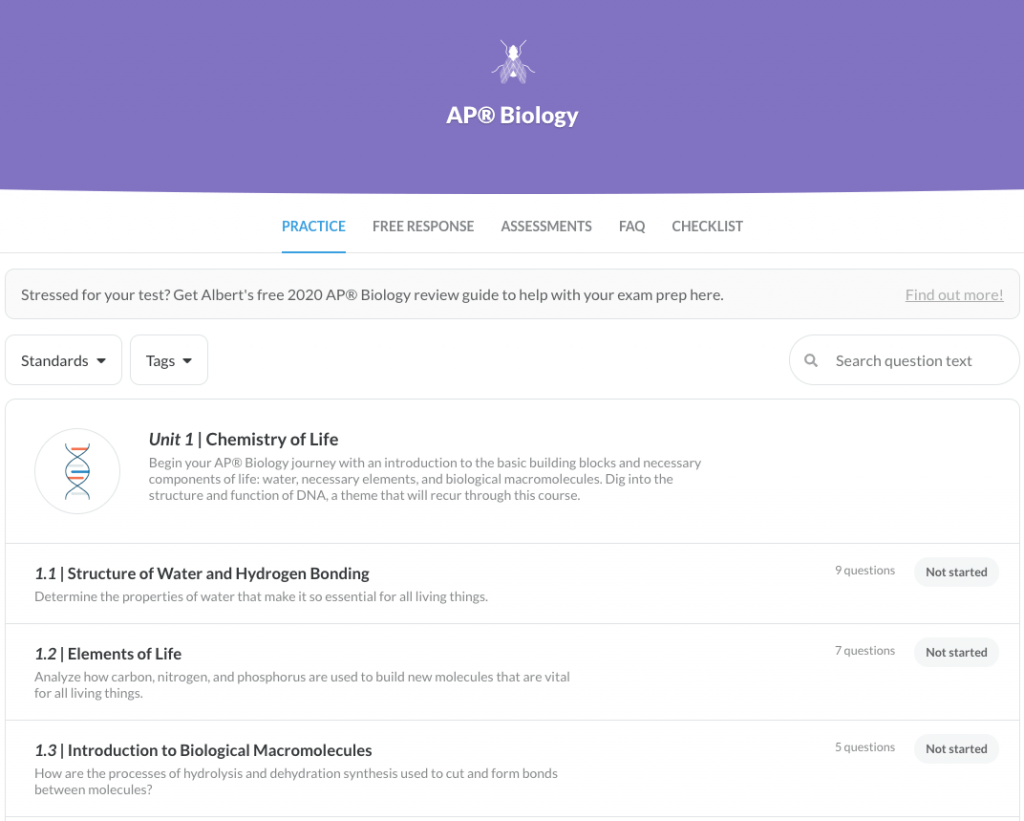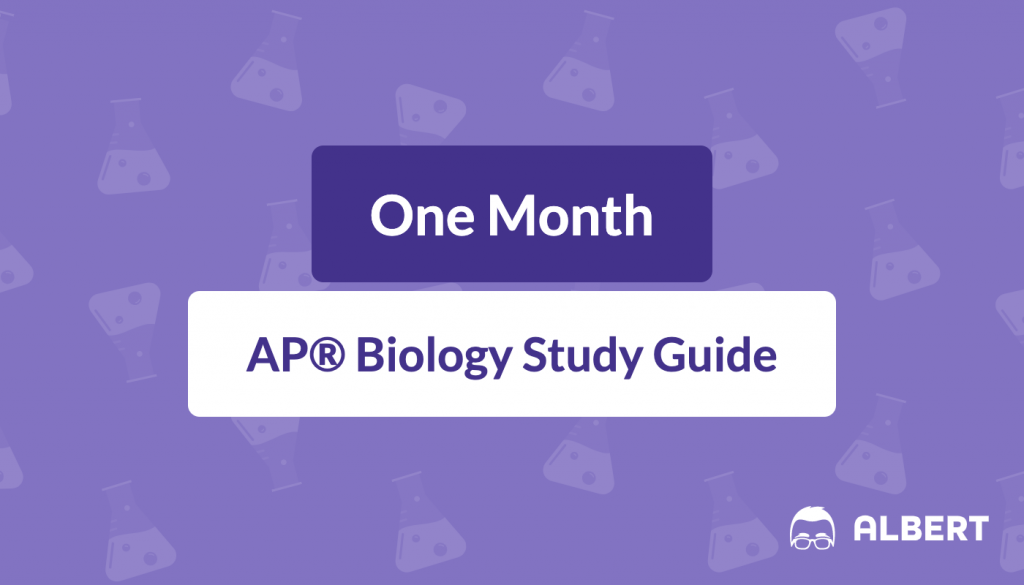If you’ve been paying attention in your class, you probably know that biology is a bit of a big deal. And between a whole lot of tiny details and big ideas in the subject, you couldn’t be blamed if you found an upcoming exam for biology a bit daunting, too. But don’t worry, we’re here to help. This one-month study plan is specially designed to help you review and retain all the information you need to be prepared for the AP® Biology exam. Whether you’re brushing up on concepts you are fairly confident about or relearning information you struggled with, you will come out of this month feeling confident about biology in all its breadth and complexity.
So, ready to tackle a course on the very fabric of life? A few notes before we begin: Feel free to adapt this study plan to whatever suits you best. How you review the information and what parts of the study plan you focus on should be altered to fit how you learn best. You’re the one learning all of this, after all, so make sure you do it in a way that makes it easiest for you to learn. Also, make sure to take care of yourself throughout this study period, particularly as the exam gets closer. Not only do you probably not want to ruin your life over an exam, but self-care can also prove incredibly useful for your performance on the exam. Eating and sleeping well is a big part of helping our brains learn and remember new information. Use that to your advantage!
What you’ll need:

- Our primary tool for this AP® study guide will be Albert.io’s practice questions for AP® Biology. This is a great tool for quizzing your knowledge, and covering a wide variety of both course material and format. They also give great feedback on your questions to help you understand not just which answer is right, but why.
- Some form of note-taking materials, be it a word processor on your computer, paper and pens, or whatever other medium you prefer. This is a lot of ground to cover, and having both a written record of the key points that you can review will be super important to remembering what you’ll need to know. The act of writing (or typing) it down also reinforces the information by applying it to a new context, helping cement your memory.
- You’ll also want to have access to AP® Central’s free response questions from previous years. These are actual questions asked on previous years, so you can gain a lot of insight into the sort of question you’ll be asked on your own exam. We’ll also use a few of them to test your knowledge and question-answering skills on some of our review days.
- Finally, you’ll definitely want your own AP® Textbook or another of equivalent reliability. We’re going to be focused on the big ideas of biology and how AP® Bio’s coursework applies in an exam setting, but sometimes it will be helpful to do more research on a concept or key term you’re having trouble grasping. In those cases, a thick old textbook is just what you need.
Optional (but helpful) stuff:
- Any AP-style workbooks or study guides your teacher provides or any supplemental material that you find helps your understanding of the main materials. Biology can get pretty intricate, and sometimes you might have trouble with how Albert.io or your textbook presents a big idea. For those times, having another source that might frame the idea in a different way can be a powerful tool.
- Flashcards, or a flashcard making site like Quizlet. This is a great way to define and remember key terms and ideas you may struggle with. If you use them, make sure to keep them updated with terms from your notes regularly .
What We Review
Day 1–3: Unit 1 – Chemistry of Life
Unit 1 Subtopics (1.1–1.6):
- 1.1 | Structure of Water and Hydrogen Bonding
- 1.2 | Elements of Life
- 1.3 | Introduction to Biological Macromolecules
- 1.4 | Properties of Biological Macromolecules
- 1.5 | Structure and Function of Biological Macromolecules
- 1.6 | Nucleic Acids
Day 1
Read/review Unit 1.1 and 1.2 (Structure of Water, Hydrogen Bonding, and Elements of Life) in your primary text or AP® Biology review book. Take notes focusing on water’s properties (cohesion, adhesion, specific heat) and why carbon, hydrogen, oxygen, nitrogen, phosphorus, and sulfur are essential for life.
Practice: In your online platform or notes, tackle a mix of multiple-choice questions related to water properties and elements of life.
Day 2
Dive into Unit 1.3 and 1.4 (Biological Macromolecules). Understand how monomers combine into polymers, and why their shapes matter (e.g., proteins, carbohydrates, lipids). Watch a short video or Crash Course segment on macromolecule structures, if helpful.
Practice: Complete multiple-choice questions on these macromolecules. Pay close attention to explanations and revise your notes accordingly.
Day 3
Cover Unit 1.5 and 1.6 (Macromolecule Function + Nucleic Acids). Deepen your understanding of DNA vs. RNA structures and their role.
Practice: Try the “Long Free Response” for Unit 1 to practice a more in-depth essay-style response. Wrap up by doing the “AP® Biology | Unit 1 Assessment” to gauge which areas still need attention.
Day 4–6: Unit 2 – Cell Structure and Function
Unit 2 Subtopics (2.1–2.11):
- 2.1 | Cell Structure: Subcellular Components
- 2.2 | Cell Structure and Function
- 2.3 | Cell Size
- 2.4 | Plasma Membranes
- 2.5 | Membrane Permeability
- 2.6 | Membrane Transport
- 2.7 | Facilitated Diffusion
- 2.8 | Tonicity and Osmoregulation
- 2.9 | Mechanisms of Transport
- 2.10 | Cell Compartmentalization
- 2.11 | Origins of Cell Compartmentalization
Day 4
Read 2.1–2.3, focusing on the structure of organelles, how cell size relates to function, and why cells compartmentalize. Create sketches or diagrams of eukaryotic vs. prokaryotic cells.
Practice: Short multiple-choice drills on basic cell structures.
Day 5
Review 2.4–2.7: membranes and transport (simple diffusion, facilitated diffusion, active transport).
Day 6
Finish up 2.8–2.11: osmoregulation, tonicity, and the origins of membrane-bound organelles (endosymbiosis).
Investigative Lab Connection: Do “Lab 4: Diffusion and Osmosis” from the Investigative Labs set. Familiarize yourself with the concepts of water potential and solute potential.
Practice: Tackle the “Long Free Response” for Unit 2 or the “AP® Biology | Unit 2 Assessment”. Focus on explaining diffusion and osmosis thoroughly—commonly tested topics.
Day 7–9: Unit 3 – Cellular Energetics
Unit 3 Subtopics (3.1–3.7):
- 3.1 | Enzyme Structure
- 3.2 | Enzyme Catalysis
- 3.3 | Environmental Impacts on Enzyme Function
- 3.4 | Cellular Energy
- 3.5 | Photosynthesis
- 3.6 | Cellular Respiration
- 3.7 | Fitness (energy use & adaptation)
Day 7
Review 3.1–3.3 on enzymes. Understand how enzymes lower activation energy and how pH/temperature affect enzyme shape and function.
Investigative Lab Connection: Perform the planning or a virtual simulation for “Lab 13: Enzyme Activity.” Observe how different variables (temperature, pH, substrate concentration) influence enzyme rates
Practice: Multiple-choice or short free-response on enzyme kinetics.
Day 8
Study 3.4 and 3.5: Cellular Energy + Photosynthesis.
Investigative Lab Connection: “Lab 5: Photosynthesis.”
Practice: Attempt the short-answer free-response for photosynthesis.
Day 9
Finish 3.6 and 3.7 on Cellular Respiration and how ATP usage ties to organismal fitness.
Investigative Lab Connection: “Lab 6: Cellular Respiration.” Review experimental setups that measure O₂ consumption. If time allows, also look over “Lab 10: Energy Dynamics” for an ecosystem-level view (though we’ll highlight it again later under ecology).
Practice: Complete the “AP® Biology | Unit 3 Assessment.” Try a long free-response question involving both photosynthesis and respiration comparisons.
Day 10–12: Unit 4 – Cell Communication and Cell Cycle
Unit 4 Subtopics (4.1–4.7):
- 4.1 | Cell Communication
- 4.2 | Introduction to Signal Transduction
- 4.3 | Signal Transduction
- 4.4 | Changes in Signal Transduction Pathways
- 4.5 | Feedback
- 4.6 | Cell Cycle
- 4.7 | Regulation of Cell Cycle
Day 10
Read 4.1–4.3 on cell-to-cell communication and signal transduction. Understand the big picture (ligand, receptor, transduction, response).
Practice: Short multiple-choice or short-answer free-response that asks you to interpret or model signal pathways (e.g., G-proteins, second messengers).
Day 11
Dive into 4.4 and 4.5 regarding changes in pathways and feedback loops (negative vs. positive).
Practice: Small set of multiple-choice or free-response tasks focusing on feedback mechanisms (e.g., body temperature regulation, blood glucose levels).
Day 12
Cover 4.6 and 4.7 on the cell cycle (interphase, mitosis) and its regulation by checkpoints.
Investigative Lab Connection: “Lab 7: Cell Division.” Review how to identify mitotic phases under a microscope and measure cell-cycle length.
Practice: “AP® Biology | Unit 4 Assessment.”
Day 13–15: Unit 5 – Heredity
Unit 5 Subtopics (5.1–5.6):
- 5.1 | Meiosis
- 5.2 | Meiosis and Genetic Diversity
- 5.3 | Mendelian Genetics
- 5.4 | Non-Mendelian Genetics
- 5.5 | Environmental Effects on Phenotype
- 5.6 | Chromosomal Inheritance
Day 13
Study 5.1 and 5.2: Meiosis and how it leads to genetic diversity. Compare/contrast it with mitosis.
Practice: Multiple-choice or short-answer tasks clarifying crossing over, independent assortment, and random fertilization.
Day 14
Review 5.3–5.4 (Mendelian vs. Non-Mendelian). Dive into Punnett squares, testcrosses, incomplete dominance, codominance, and sex-linked traits.
Practice: Work through a few “Short Answer Free Response” problems covering the variety of inheritance patterns.
Day 15
Finish 5.5 and 5.6 on environmental influences (e.g., temperature-dependent sex determination) and chromosomal inheritance (linked genes, gene maps).
Practice: Tackle the “AP® Biology | Unit 5 Assessment.” If you have extra time, begin a more challenging or long free-response question that combines multiple inheritance patterns.
Day 16–18: Unit 6 – Gene Expression and Regulation
Unit 6 Subtopics (6.1–6.8):
- 6.1 | DNA and RNA Structure
- 6.2 | Replication
- 6.3 | Transcription and RNA Processing
- 6.4 | Translation
- 6.5 | Regulation of Gene Expression
- 6.6 | Gene Expression and Cell Specialization
- 6.7 | Mutations
- 6.8 | Biotechnology
Day 16
Read 6.1–6.3, focusing on nucleic acid structure, DNA replication, and basics of transcription (mRNA, splicing).
Practice: Multiple-choice or short-answer free-response that tests your understanding of how DNA is copied and turned into RNA.
Day 17
Cover 6.4–6.6 on translation, regulation of gene expression (operons, transcription factors), and how cells specialize by turning genes on/off.
Practice: A set of multiple-choice questions or a short free response analyzing an operon or eukaryotic gene regulation scenario.
Day 18
Finish 6.7–6.8: Mutations and Biotechnology. Explore the effects of point mutations, frameshifts, CRISPR, gel electrophoresis, etc.
Investigative Lab Connection: “Lab 8: Bacterial Transformation” and “Lab 9: Restriction Enzyme Analysis”. These labs are perfect to illustrate gene transfer and fragment analysis.
Practice: “AP® Biology | Unit 6 Assessment.” If time allows, outline or respond to a long free-response question about the lac operon or a biotechnology scenario.
Day 19–21: Unit 7 – Natural Selection
Unit 7 Subtopics (7.1–7.13)
- 7.1 | Introduction to Natural Selection
- 7.2 | Natural Selection
- 7.3 | Artificial Selection
- 7.4 | Population Genetics
- 7.5 | Hardy-Weinberg Equilibrium
- 7.6 | Evidence of Evolution
- 7.7 | Common Ancestry
- 7.8 | Continuing Evolution
- 7.9 | Phylogeny
- 7.10 | Speciation
- 7.11 | Extinction
- 7.12 | Variations in Populations
- 7.13 | Origin of Life on Earth
Day 19
Review 7.1–7.3 on natural selection and artificial selection (breeding).
Investigative Lab Connection: “Lab 1: Artificial Selection.” See how scientists can breed plants/animals for desired traits.
Practice: Short multiple-choice focusing on selection pressures and basic population genetics.
Day 20
Study 7.4–7.7: Population Genetics, Hardy-Weinberg, and evidence for evolution (fossil record, biogeography, homologies).
Investigative Lab Connection: “Lab 2: Mathematical Modeling.” Use Hardy-Weinberg formulae to track allele frequencies.
Practice: Short free-response or multiple-choice on Hardy-Weinberg.
Day 21
Finish 7.8–7.13: common ancestry, phylogenetic trees, speciation, extinction, and the origin of life.
Investigative Lab Connection: “Lab 3: Comparing DNA Sequences.” Great for analyzing molecular evidence.
Practice: “AP® Biology | Unit 7 Assessment.”
Day 22–24: Unit 8 – Ecology
Unit 8 Subtopics (8.1–8.7):
- 8.1 | Responses to the Environment
- 8.2 | Energy Flow Through Ecosystems
- 8.3 | Population Ecology
- 8.4 | Effect of Density of Populations
- 8.5 | Community Ecology
- 8.6 | Biodiversity
- 8.7 | Disruptions to Ecosystems
Day 22
Cover 8.1–8.2: Organism responses and energy flow (food chains, food webs, primary productivity).
Investigative Lab Connection: “Lab 10: Energy Dynamics.” A perfect match for exploring modeling of energy/matter flow.
Practice: Multiple-choice or short-answer on trophic levels, energy pyramids, and the 10% rule.
Day 23
Study 8.3–8.4: Population Ecology and density-dependent vs. density-independent factors.
Investigative Lab Connection: “Lab 11: Transpiration.” Though plant-focused, it also ties back to how environment factors influence organismal processes.
Practice: Try short free-response explaining logistic or exponential growth curves.
Day 24
Wrap up 8.5–8.7: Community interactions, biodiversity, and environmental disruptions (invasive species, climate change).
Investigative Lab Connection: “Lab 12: Fruit Fly Behavior.” Observe how organisms behave in response to stimuli—an ecology-meets-ethology approach.
Practice: “AP® Biology | Unit 8 Assessment.”
Day 25–28: Full-Length Practice Exams
Over the next four days, you’ll simulate official exam conditions using the updated practice exam sets. Each day, focus on one full exam (both multiple-choice and free-response), then review your results carefully.
Day 25
Take AP® Biology | Practice Exam #1 (Multiple Choice + Free Response). Time yourself strictly. Afterward, score your free responses using the guidelines provided and identify areas of weakness.
Day 26
Take AP® Biology | Practice Exam #2 (Multiple Choice + Free Response). Reflect on whether you’ve improved from Exam #1. Revisit any content areas you still find troubling.
Day 27
Take AP® Biology | Practice Exam #3 (Multiple Choice + Free Response). Use targeted review to fix any lingering misunderstandings in specific units.
Day 28
Take AP® Biology | Practice Exam #4 (Multiple Choice + Free Response). Now that you’ve done four full tests, you should see a clear pattern of strengths and weaknesses.
Day 29: Unit Assessments and Reinforcement
If you have access to them, recheck any “AP® Biology | Unit Assessments” you have not yet completed or want to improve upon. This is your chance to do final targeted practice in the units where you missed the most questions during the practice exams. Tackle a mix of short-answer and long free-response tasks from each unit to reinforce your ability to write effectively under time pressure. Consider creating or revisiting flashcards for high-yield concepts (e.g., biochemical pathways, traits of each domain of life, or key definitions in ecology).
Day 30: Final Review and Next Steps
Do a quick “last pass” review of your notes:
- Reexamine tricky labs (e.g., Photosynthesis, Cellular Respiration) for the setup and main takeaways.
- Scan for important equations or formulas (Hardy-Weinberg, water potential, standard error, etc.).
- Remind yourself of the big picture themes: evolution, energetics, communication, heredity, gene expression, ecology.
- Visit the official College Board website for any final free-response question sets or scoring guidelines you haven’t used yet.
- Make a test-day checklist: sharpened pencils, pens, fully charged calculator if allowed, watch/clock, snacks, etc.
- Celebrate your hard work! You’ve covered all major AP® Biology units comprehensively in 30 days.
And there you have it! You have now successfully completed Albert.io’s 1 month AP® Biology study plan. Congratulations!
You should be both confidently knowledgeable in all the ups, downs, ins, and outs of the AP® Biology course and well-versed in the sorts of questions you’ll be dealing with on the exam itself. Remember to take the exam seriously, but don’t let its importance or intimidation factor daunt you. In the end, it is just one test in one specific subject area. If you manage to stick to this plan, you should be more than ready. We’re sure you’ll do great. For information on other AP® exams and the other study guides we offer, head to Albert.io or check out our other blog posts.
Need help preparing for your AP® Biology exam?

Albert has hundreds of AP® Biology practice questions, free response, and full-length practice tests to try out.








